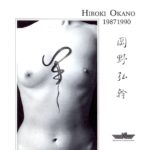
Hiroki Okano’s debut 19871990 is startling in more ways than one. A trailblazing stew of new form Japanese ambient and new age minimal music isn’t something you normally see coming out of Germany’s Innovative Communication label. Also surprising, is that for such a fully formed debut, what we’re hearing is actually a collection of works spanning three years in the life of Hiroki Okano.

Born in Osaka, Hiroki began his career in 1987 writing music for modern dance troupes, film, and performance theater. Somewhere, down the line, his love of Japanese folk music, due to his Buddhist practice, translated to experimenting with ways to modernize tradition. Working with commercial companies like Seiko and Panasonic, Hiroki was able to build environmental sound installations that could shift an audience’s perspective. Installations where thousands of hung Japanese wind bells were hung near waterfalls, rivers, fences, and rock ledges, allowed its audience to feel the influential role spatial, local sounds played in developing what they consider is a traditional Japanese folk aesthetic.
We, Japanese or world music bloggers, must crack a little smile every time we hear another shakuhachi or marimba-sounding instrument as typifying something intrinsically “Asian” because it feeds that very small musical bias that sidelines many with little patience. Take that and compound it with some wordless chanting, and you have the recipe for turning off many readers not expecting to be pitched the next Kitaro as the new Midori Takada. When you hear the opening track on 19871990, created in 1987, your mind starts to wander off, because it feeds exactly on that prejudice. Does the world need another Kitaro? It appears Innovative Communication, thought they did based on that track. Luckily, for us, 19871990 wasn’t the album that would do it.
Finding homeward influence in the new breed of Japanese composers who took their cues from modern Japan, Hiroki projects forward, attempting to build a bridge between electronic environmental music and a spatial Japanese folk tradition. It all begins with a false flag, of sort, sending you towards the stars with the spaciest/most synthetic track kicking off the album only to bring you down and show you the most intriguing tracks are the earthly influenced. The second track, “1.7*10,-25 (m2, 1989)”, as the name suggests, tries to shift your focus by creating an infinite sound through more human means. Basing this composition on mallet percussion, chant, and affected/treated acoustic guitar, it’s Hiroki’s first cut that truly takes us somewhere unexpected.
The album unfolds like a sonic traverse. “Sand (m3, 1989)” sounds appropriately like a slipstream of shifting sonics, with gurgling synth and contrapoint guitar undulating around each other trying to remain above some kind of aural horizon. “Sea (m4, 1990)”, made a year afterward, blends into the previous track, featuring dusky glissando bass lines and unplaceable resonances as boundaries for Hiroki’s first ethereal vocals to sustain over. This is as close as Hiroki gets to sounding like the moodiest/haziest bits of the ICC label. Then, as soon as you find you’re in for a certain groove, “Drop (m5, 1987)” treats you to a nostalgic sonic ode to an unlikely influence of Hiroki…the music of The Durutti Column. It’s such a simple song, one revolving around heavily treated electric guitars and percolating drum machines, swirling gracefully around each other, with very faint spoken word interludes sneaking in, adding up to a reminder that influence can travel both ways.
The second half off the album beginning from the crystalline “Road (m6, 1988)” and on to its finale, the ageless/unplaceable “Kagome (m9, 1990)”, goes even further with deeper moods and warping melodies. From the spritely, woodsy Eno-like ambience of the former to the Hiroshi Yoshimura-like “Kyoto (m7, 1988)” and “Stream (m8, 1988)” that rolls in open-hearted wind sounds (real and synthetic) into delicate, wooly recordings of streams and chimes, Hiroki plucks certain beauty from rarely heard of corners. When you hear Hiroki add his barely there vocals, in “Stream (m8, 1988)”, 19871990 becomes this timeless thing that sounds like rare else, in any time.
Deeply intriguing, and rewarding, 19871990 is an album that sounds remarkably current, yet, has a certain quality that ignores time, keeping it classical, ever-living, no matter the era someone, anyone, keeps discovering it. The only struggle is to find another sphere of communion, with some other musical planet, to place it with. On this day, I’m thinking of Geinoh Yamashirogumi’s Ecophony Gaia. A collection of music where the earthly world is the highest source of inspiration. Where things that matter are at a bit more important than us. That can’t be bad company to hold, right?
